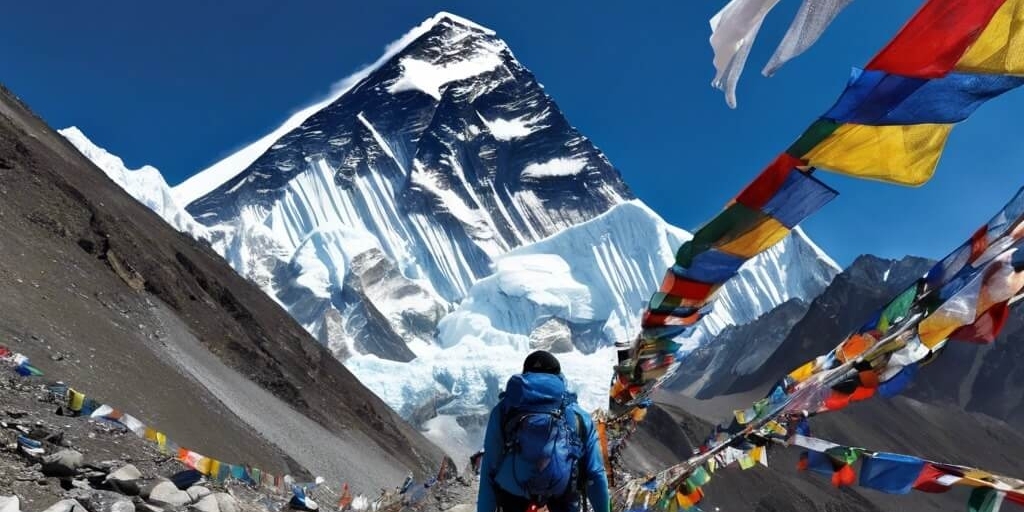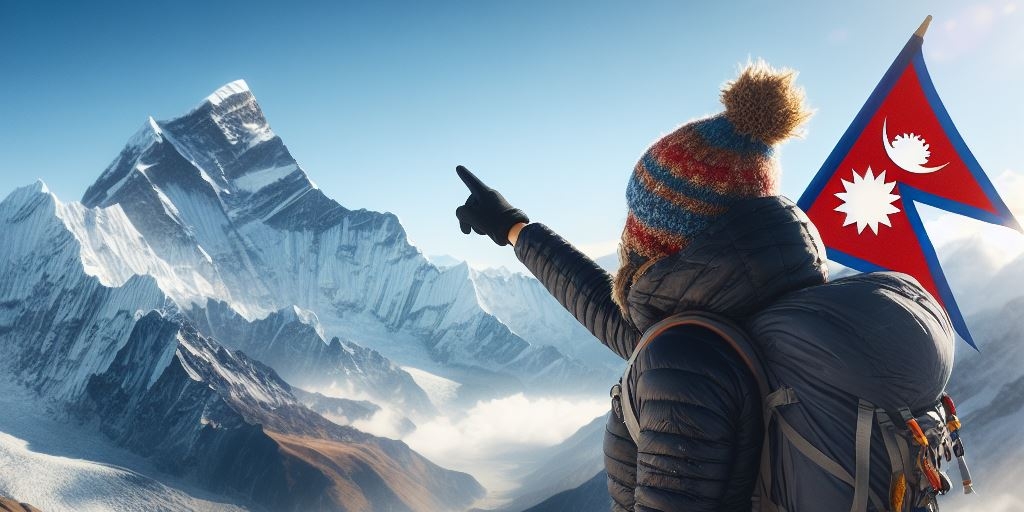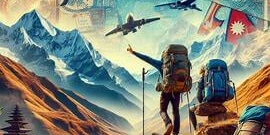Das ultimative Abenteuer: Die Everest Base Camp Trekking Tour
Willkommen bei dem ultimativen Abenteuer: der Everest Base Camp Trekking Tour. Tauchen Sie ein in die atemberaubende Schönheit des Himalaya und erle...

Are you ready to embrace the thrill of a lifetime?
Nepal's majestic Himalayas beckon all adventure enthusiasts, offering
breathtaking landscapes and unparalleled trekking experiences. But before you
strap on your hiking boots and venture into the unknown, it's essential to be
well-prepared.
In this beginner's guide to trekking in Nepal, we'll
equip you with all the information you need to embark on a memorable journey.
From choosing the right trekking route based on your fitness level to essential
packing tips, we've got you covered.
Nepal's diverse terrain caters to both novice
trekkers and seasoned hikers, with a plethora of trails suitable for all
abilities. Whether you dream of conquering the famous Annapurna Circuit or
glimpsing the world's highest peak at Everest Base Camp, there's a trek for
everyone.
Immerse yourself in the lush valleys, vibrant
cultures, and the warm hospitality of the Nepalese people. From navigating
challenging terrains to experiencing the magic of remote Himalayan villages,
this guide will empower you to step out of your comfort zone and make lifelong
memories.
Get ready to transform into an intrepid explorer and
uncover the wonders of the Himalayas. Let the adventure begin!
Nepal boasts an extensive network of trekking routes,
each offering unique experiences and breathtaking views. Here are some of the
most popular trekking routes in the Himalayas:
1. Everest Base Camp Trek
The Everest Base Camp Trek is a bucket-list adventure
for many trekkers. This iconic trail takes you deep into the heart of the
Khumbu region, offering stunning views of Everest, Lhotse, and Ama Dablam. The
trek starts with a scenic flight to Lukla and continues through picturesque
Sherpa villages, ancient monasteries, and glacial moraines. The highlight of
the trek is reaching Everest Base Camp, where you can stand in the footsteps of
mountaineering legends.
2. Annapurna Circuit Trek
The Annapurna Circuit Trek is renowned for its
diverse landscapes and cultural experiences. This classic trek takes you around
the Annapurna Massif, crossing high mountain passes and charming villages. From
terraced fields and rhododendron forests to the dramatic Thorong La Pass, this
trek is a feast for the eyes. Along the way, you'll encounter welcoming
teahouses, ancient temples, and the famous Muktinath shrine.
3. Langtang Valley Trek
The Langtang Valley Trek offers a captivating journey
through the Langtang National Park, known for its pristine forests and alpine
meadows. This trek is a great option for those short on time or seeking a less
crowded trail. As you ascend through lush rhododendron forests and yak
pastures, you'll be rewarded with panoramic views of Langtang Lirung and other
snow-capped peaks. The trek also provides an opportunity to interact with the
warm-hearted Tamang and Sherpa communities.
Choosing the right time to go trekking in Nepal is
crucial for a memorable experience. The country experiences four distinct
seasons, each offering different trekking conditions. Here's a breakdown of the
best time to trek in Nepal:
1. Spring (March to May)
Spring is one of the most popular seasons for
trekking in Nepal. The weather is mild, and the landscapes come alive with
blooming flowers and lush greenery. The skies are generally clear, offering
excellent visibility of the mountains. However, popular trails like Everest
Base Camp and Annapurna Circuit can get crowded during this time.
2. Autumn (September to November)
Autumn is considered the best time to trek in Nepal.
The weather is stable, with clear skies and moderate temperatures. The mountain
views are at their best, and the trails are less crowded compared to the spring
season. This is an ideal time for trekking in the Everest and Annapurna regions,
as well as other popular routes.
3. Winter (December to February)
Winter brings colder temperatures and occasional
snowfall to the higher regions of Nepal. While some treks, like the Everest
Base Camp Trek, can still be done during this time, it requires proper gear and
experience. The advantage of trekking in winter is the peaceful trails and
stunning snowy landscapes.
4. Monsoon (June to August)
The monsoon season brings heavy rainfall and high
humidity to Nepal. Trekking during this time is not recommended due to slippery
trails, leeches, and limited mountain views. However, certain regions like
Upper Mustang and Dolpo lie in the rain shadow and can be trekked during this
season.
Trekking in the Himalayas requires careful planning
and preparation to ensure a safe and enjoyable journey. Here are some essential
tips to help you prepare for your Himalayan adventure:
1. Research and choose the right trek
Research different trekking routes and choose one
that matches your fitness level, time constraints, and desired experiences.
Consider factors like altitude, difficulty level, and cultural highlights along
the route.
2. Get in shape
Trekking in the Himalayas can be physically
demanding. Start a fitness routine a few months before your trek to build
stamina and strength. Focus on cardiovascular exercises, hiking with a loaded
backpack, and leg strength exercises.
3. Obtain necessary permits
Certain trekking areas in Nepal require permits, such
as the Annapurna Conservation Area Permit (ACAP) and Sagarmatha National Park
Permit. Make sure to obtain these permits before starting your trek.
4. Pack wisely
Pack essential clothing, gear, and equipment for your
trek. Layers are key to adapt to changing weather conditions, and good-quality
hiking boots are a must. Don't forget to bring a first aid kit, water
purification tablets, and a sturdy backpack.
5. Train your body for altitude
Altitude sickness is a common concern when trekking
in the Himalayas. Gradual acclimatization is crucial to avoid altitude-related
illnesses. Plan your trek itinerary with proper rest days and gain altitude
gradually.
6. Stay hydrated and eat well
Proper hydration and nutrition are vital during a
trek. Drink plenty of water and consume nutritious meals to keep your energy
levels up. Avoid excessive alcohol consumption and maintain a balanced diet.
7. Pack a positive mindset
Trekking in the Himalayas can be physically and
mentally challenging. Cultivate a positive mindset, embrace the journey, and
take time to appreciate the natural beauty and cultural experiences along the
way.
Having the right gear and equipment is essential for
a successful and comfortable trekking experience in Nepal. Here's a comprehensive
list of essentials:
1. Clothing
- Base layers: Moisture-wicking and quick-drying
shirts and pants
- Insulating layers: Fleece jackets, down jackets,
and thermal leggings
- Waterproof and windproof outer layers: Rain
jackets, rain pants, and windproof trousers
- Trekking pants and shorts
- Hiking socks and liners
- Warm hats, gloves, and neck gaiters
- Sunglasses and sun hat
2. Footwear
- Hiking boots with ankle support
- Trekking sandals or lightweight shoes for
lower-altitude walks
- Gaiters to protect against snow, rocks, and debris
3. Backpack and accessories
- Sturdy backpack with a capacity of 40-60 liters
- Waterproof backpack cover
- Sleeping bag suitable for cold temperatures
- Trekking poles for stability and reducing strain on
knees
- Headlamp with extra batteries
- Water bottles or hydration bladder
- Snacks and energy bars
4. Sleeping essentials
- Sleeping mat or mattress
- Sleeping bag liner for added warmth and cleanliness
- Earplugs and eye mask for better sleep quality
5. Personal hygiene and first aid
- Toiletries: Toilet paper, wet wipes, hand
sanitizer, and sunscreen
- First aid kit with basic medications, bandages, and
blister treatment
- Insect repellent and mosquito net
- Personal medications and prescriptions
6. Miscellaneous
- Trekking map and guidebook
- Camera or smartphone for capturing memories
- Power bank or extra batteries for electronic
devices
- Duct tape, ziplock bags, and carabiners for
miscellaneous needs
Remember to pack light and only bring the essentials
to avoid unnecessary weight on your trek. Consider renting or buying gear in
Kathmandu or Pokhara if you don't have specific items.
Trekking in the Himalayas requires a certain level of
physical fitness and endurance. Preparing your body for the demands of trekking
will enhance your experience and reduce the risk of injuries. Here are some
training tips:
1. Cardiovascular exercises
Engage in activities that improve your cardiovascular
fitness, such as jogging, cycling, swimming, or stair climbing. Aim for at
least 30 minutes of aerobic exercise, three to four times a week.
2. Strength training
Include strength exercises in your routine to build
endurance and muscle strength. Focus on exercises that target your legs, core,
and upper body. Squats, lunges, planks, and push-ups are great options.
3. Hiking with a loaded backpack
Simulate the conditions of trekking by hiking with a
loaded backpack. Start with shorter hikes and gradually increase the duration
and weight of your backpack. This will help you build stamina and get
accustomed to carrying the load.
4. Altitude training
If possible, incorporate altitude training into your
fitness routine. This can be done by hiking or exercising at higher altitudes
or using altitude training masks. Altitude training helps your body adapt to
lower oxygen levels.
5. Practice long walks
Increase your endurance by going on long walks or
hikes on weekends. This will help condition your body for long days of
trekking.
Remember to consult with a healthcare professional
before starting any new exercise regimen. They can provide personalized advice
based on your fitness level and any pre-existing medical conditions.
Trekking in the Himalayas involves certain risks, and
it's important to prioritize your safety throughout your journey. Here are some
safety precautions and considerations to keep in mind:
1. Acclimatization
Proper acclimatization is crucial to avoid altitude
sickness. Ascend gradually, take rest days, and drink plenty of water. If you
experience symptoms like headache, dizziness, or nausea, descend to a lower
altitude immediately.
2. Hydration and water purification
Stay hydrated by drinking at least 3-4 liters of
water per day. Carry water purification tablets or a water filter to ensure
safe drinking water along the trek.
3. Follow the guidance of your guide
If you're trekking with a guide or porter, listen to
their advice and follow their instructions. They have valuable knowledge and
experience to ensure your safety.
4. Be prepared for weather changes
The weather in the mountains can change rapidly. Pack
appropriate clothing layers and be prepared for rain, snow, wind, and cold
temperatures. Always check the weather forecast before setting off.
5. Stay on designated trails
Stick to the marked trails and avoid taking
shortcuts. Deviating from the designated paths can lead to dangerous situations
or getting lost.
6. Respect local customs and culture
Nepal is a culturally rich country with diverse traditions
and customs. Respect the local culture, dress modestly, and ask for permission
before taking photographs of people or religious sites.
7. Travel insurance
Obtain comprehensive travel insurance that covers
trekking activities and emergency medical evacuation. Make sure to read the
policy terms and conditions carefully.
By following these safety precautions and being
mindful of your surroundings, you can have a safe and enjoyable trekking
experience in Nepal.
During your trek in Nepal, you'll have various
accommodation and food options along the trails. Here's what you can expect:
1. Teahouses
Teahouses are the most common form of accommodation
along popular trekking routes. These are small guesthouses that offer basic
rooms with shared bathrooms. Teahouses provide warm beds, blankets, and meals.
The menu at teahouses typically includes a variety of Nepali and international
dishes, such as dal bhat (lentil soup with rice), noodles, momos (dumplings), and
fried rice. Vegetarian options are readily available.
2. Camping
In less developed or remote areas, camping is the
only option for accommodation. Trekking agencies can arrange camping equipment,
including tents, sleeping bags, and cooking facilities. Camping allows you to
enjoy the solitude of nature but requires additional logistics and a support
team.
3. Homestays
For a more immersive cultural experience, some treks
offer homestay accommodations. This involves staying with local families in
traditional houses, sharing meals and experiences with them. Homestays provide
a unique opportunity to learn about the local culture and way of life.
4. Packaged trekking
For those seeking a more luxurious trekking
experience, packaged treks offer comfortable lodges and hotels along the route.
These treks provide a higher level of comfort and often include additional
services like hot showers, Wi-Fi, and western-style meals.
It's important to note that accommodation options may
vary depending on the trekking route and the season. During peak seasons,
teahouses can get crowded, so it's advisable to book in advance.
Trekking in Nepal is not just about the stunning
landscapes; it's also an opportunity to immerse yourself in the rich culture
and traditions of the Nepalese people. Here are some cultural highlights and
experiences you can encounter along the trekking routes:
1. Buddhist monasteries
As you trek through the Himalayas, you'll come across
ancient Buddhist monasteries and stupas, their colorful prayer flags fluttering
in the mountain breeze. These havens of peace are not just architectural
marvels; they offer a glimpse into the rich spiritual traditions of Nepal.
Stepping
Inside:
Upon entering a monastery, you'll likely be greeted
by the gentle aroma of incense and the rhythmic chanting of monks. Explore the
courtyards adorned with prayer wheels and intricate mandalas. Immerse yourself
in the serene atmosphere and observe the daily rituals practiced by the monks,
gaining a deeper understanding of Buddhist philosophy and beliefs.
Unique
Experiences:
·
Tengboche
Monastery: Perched atop a hill on the Everest Base Camp Trek,
Tengboche Monastery offers breathtaking views of Everest and surrounding peaks.
Witness the vibrant Mani Rimdu festival in November, where masked dances and
chanting create a mesmerizing spectacle.
·
Kopan
Monastery: Located near Kathmandu, this monastery provides a chance to
learn about Buddhism through meditation courses and teachings. Spend time
interacting with the monks, gaining insights into their way of life and
fostering a sense of peace and well-being.
Beyond the
Monasteries:
Your encounter with Buddhism extends beyond the
monasteries. Witness locals spinning prayer wheels, murmuring mantras, and
lighting butter lamps as offerings. These everyday practices offer a profound
connection to the culture and its deep-rooted spirituality.
2. Immersing
Yourself in the Warmth of Village Life:
Venture beyond the well-trodden paths and delve into
the charming villages nestled amidst the mountains. Here, you'll be welcomed
with the infectious smiles and genuine hospitality of the Nepalese people.
Engage in conversations with locals, learning about their traditions and daily
lives. Be mesmerized by the vibrant folk music and dance performances, often
showcasing colorful costumes and rhythmic beats. Embrace the opportunity to
witness traditional craft demonstrations, from intricate woodcarving to
handwoven textiles, gaining appreciation for their timeworn skills and artistic
heritage.
3. Savoring
the Delights of Nepalese Cuisine:
Trekking in Nepal is a culinary adventure in itself.
Savor authentic dishes prepared with fresh, local ingredients, each bursting
with unique flavors and textures. Indulge in a steaming bowl of dal bhat,
Nepal's national dish, featuring lentil soup, rice, and various side dishes.
Embrace the warmth of a cup of yak butter tea, a traditional beverage offering
sustenance and a comforting respite during chilly evenings. Don't miss the
opportunity to sample regional specialties, like the spicy momo dumplings or
the savory thukpa noodle soup, each reflecting the diverse culinary traditions
of different regions.
4. Witnessing
Ancient Festivals and Ceremonies:
Nepal is a land steeped in religious traditions, and
festive celebrations are an integral part of life. Throughout the year, various
communities come together to celebrate vibrant festivals and ceremonies,
offering a window into their unique cultural expressions. Witness the awe-inspiring
Dashain festival, the biggest festival in Nepal, featuring animal sacrifices,
traditional dances, and blessings from elders. Immerse yourself in the colorful
Tihar festival, the festival of lights, where houses are adorned with
illuminating marigold garlands and families gather to celebrate prosperity and
joy.
Embarking on a trekking adventure in the Himalayas is
a once-in-a-lifetime experience that requires careful planning and preparation.
By choosing the right trekking route, packing the essential gear, and training
your body, you'll set yourself up for a successful and memorable journey.
Immerse yourself in the beauty of Nepal's landscapes
and the warmth of its people. Respect the local culture, practice responsible
tourism, and leave a positive impact on the communities you encounter.
Remember to enjoy every step of the way, savoring the
breathtaking views, overcoming challenges, and celebrating your achievements. A
Himalayan adventure is not just about reaching the destination; it's about
embracing the journey and the transformation it brings.
Get ready to transform into an intrepid explorer and
uncover the wonders of the Himalayas. Let the adventure begin!

Willkommen bei dem ultimativen Abenteuer: der Everest Base Camp Trekking Tour. Tauchen Sie ein in die atemberaubende Schönheit des Himalaya und erle...

Embark on the ultimate adventure and conquer the majestic Mera Peak, nestled in the heart of the Himalayas in Nepal. Standing tall at an impressive...

Are you ready to embrace the thrill of a lifetime? Nepal's majestic Himalayas beckon all adventure enthusiasts, offering breathtaking landscapes and...
Sign up to stay updated with latest offers, recent events and more news.
